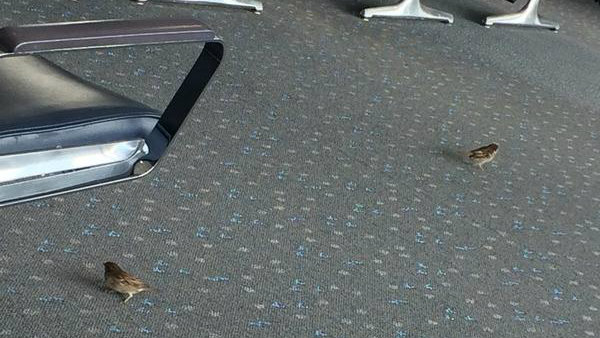
Planes aren't the only things flying at Denver International Airport. Inside the terminal and concourses, it's common to see birds flitting about. Colorado Matters host Ryan Warner wondered how they got there, whether they're stuck, and what the airport can do. Not much it turns out. He speaks with DIA spokesman Heath Montgomery who has one piece of advice: please don't feed the birds.
Transcript:
Ryan: Heath, welcome to the program. Heath: Thank you, Ryan. Ryan: Have you noticed these birds flitting about the terminal and the concourses? Heath: Well it's hard not to, they're kind of all over the place. And we know they're out there. It's a safe bet that most of the airports in the United States face some kind of bird problem inside their facility. There's just too many ways that they can get into the buildings themselves, through jet bridges, loading docks, open doors in the terminals when the passengers are moving in and out. So they've definitely been here for many years. Ryan: I wonder if they live for very long and what they might eat? Heath: You know, we're really just not sure. We certainly see them poking around the food courts and near the trash cans. We absolutely discourage employees and passengers from feeding any kind of wildlife. We want to discourage them from being in our facility but they're certainly making the best of their situation. And it's a little unknown how they're getting in and out exactly and whether they're moving outside with people and collecting food or if they're nesting and procreating in the building in places that we just don’t know about. There's some unknowns associated with this. Ryan: Well, this is interesting because I thought of the birds as 'trapped'. But you say that one possibility is that they're moving in and out and they've just made DIA home. Heath: Yeah, it's certainly a possibility that they have figured out that when people walk through those doors, the doors stay open for a few seconds and they can move in and out as they please. Ryan: Well I gather that it is a goal of yours to move them to the outside but DIA is not small and that can't be an easy task. Heath: No, it's extremely difficult to remove birds from the airport. The terminal alone is 1.5 million square feet of space with really huge expanses all the way up to the tented rooftop so you're talking many volumes on top of that square footage. And the concourses feature an additional four million square feet of space so it's a giant area to try and control with a handful of personnel who are trained to do that kind of thing. It's a very difficult task. Ryan: Have you ever tried to get a census, a number on the birds that are in the facility? Heath: No, not to my knowledge. We have made several attempts to trap them, remove them over the years. We work very closely with our partners at the USDA Wildlife teams to mitigate wildlife across the airport, and that includes inside the building. They've tried things like putting up small netting, traps, but we've not found a single technique that's successful. They're just, they've very small, they're smart and they've very fast little birds. Ryan: What kind of birds are they? Heath: I don’t know the specifics but we get a lot of sparrows, and we've even had a bat inside one of the terminals. Ryan: This USDA team you talk about, working on the inside of the airport, is the same team that would work on getting birds away from the runways so that there aren't bird strikes. Heath: Absolutely. And that's one of the challenges that we face is that they have high priorities of keeping people safe on the aircraft out on the airfield so it takes their time to come inside to the building to try and remove these little birds that really are not posing a direct safety hazard to travelers. So they have bigger fish to fry. Ryan: This sounds like an area that is just waiting for an invention. Some kind of technology that could help you get these birds out. Heath: Absolutely. We're open to innovation. If anyone has a really good idea about how to capture and remove these little birds, we're certainly open to hearing it. Ryan: Is this a question you get a lot from passengers coming through DIA that they notice the birds and they wonder if anything's being done? Heath: We do get this a lot from customers who notice the birds on the concourses as they're waiting for a plane, we see almost every day people taking pictures of their little bird friends that they've made sitting at the gate and so it's definitely something that they notice. Ryan: DIA dealing with all kinds of flight I guess. Heath: All kinds of flight. Ryan: Thanks for being with us. Heath: Thank you, Ryan. |









